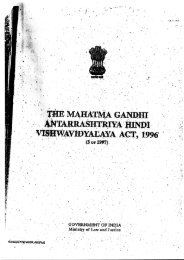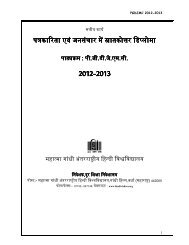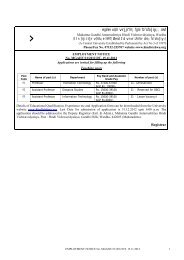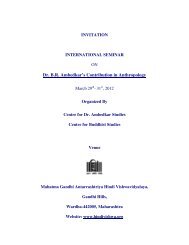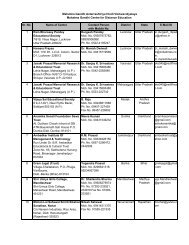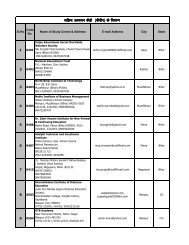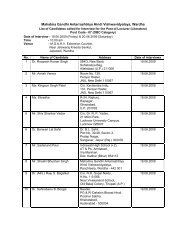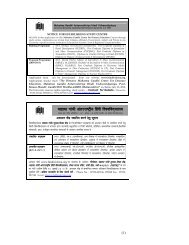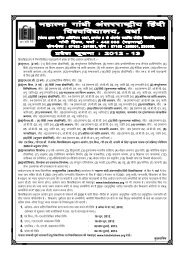A Journal of Mahatma Gandhi Antarrashtriya Hindi Vishwavidyalaya
A Journal of Mahatma Gandhi Antarrashtriya Hindi Vishwavidyalaya
A Journal of Mahatma Gandhi Antarrashtriya Hindi Vishwavidyalaya
You also want an ePaper? Increase the reach of your titles
YUMPU automatically turns print PDFs into web optimized ePapers that Google loves.
is no protagonist in the narrative. This<br />
is written with a purpose. The writer says<br />
in his foreword: “There are many books<br />
written for educating women but I have<br />
written this story in a ‘new form’ I believe<br />
that both men and women will appreciate<br />
and get benefitted after reading it. I have<br />
tried to use the spoken words <strong>of</strong> real<br />
men and women in the dialect <strong>of</strong> this<br />
region <strong>of</strong> the business class” In this novel<br />
not only the language is ‘real’ but life<br />
depicted is also ‘real’. This ‘novel’ is written<br />
for establishing the importance <strong>of</strong> education<br />
for women. Education makes woman’s<br />
outlook broad and liberal whereas<br />
uneducated woman is narrow minded and<br />
can’t handle her family properly. This<br />
‘novel’ supports widow marriage. This is<br />
the direct influence <strong>of</strong> reformist movement<br />
in India in the 19 th century. In this novel<br />
customs prevalent in business class <strong>of</strong> the<br />
region are told elaborately. The mindset<br />
<strong>of</strong> the 19 th century Indian society is also<br />
reflected in this narrative. Early ‘novels’<br />
like Vama Shikshak (1872), Bhagyawati<br />
(1877), Amrit Charitra (1888),<br />
Nissahay Hindu (1881), Pariksha Guru<br />
(1882) continue the same trend and<br />
centrality <strong>of</strong> women is worth mentioning.<br />
Dalit (oppressed) Discourse<br />
On social front the <strong>Hindi</strong> novelist also<br />
took up the cause <strong>of</strong> the downtrodden<br />
<strong>of</strong> the Indian society especially from so<br />
called ‘ untouchables among lower caste’.<br />
<strong>Mahatma</strong> <strong>Gandhi</strong> had given the<br />
nomenclature ‘Harijan’ (son <strong>of</strong> God) to<br />
this caste group. The Indian constitution<br />
abolished untouchability and made it a<br />
criminal <strong>of</strong>fence. Dalit thinkers and the<br />
followers <strong>of</strong> Dr. Bhimrao Ambedkar,<br />
chairman <strong>of</strong> drafting committee <strong>of</strong> Indian<br />
constitution and undisputed leader <strong>of</strong> Dalits<br />
preferred to call them Dalit (oppressed).<br />
Emancipation <strong>of</strong> Dalits was also one <strong>of</strong><br />
the goals <strong>of</strong> Indian Reformers. Jyotiba<br />
Phule and Dr Ambedkar were the champions<br />
<strong>of</strong> this cause.<br />
As far as my research goes a novel<br />
written in <strong>Hindi</strong> Ghar ki Raah (Search<br />
for a Home/1935) by Indra Basawada is<br />
the first dalit novel written in <strong>Hindi</strong> whose<br />
protagonist and writer himself comes from<br />
dalit society. I’m aware <strong>of</strong> the fact that<br />
the great Indian novelist and story writer<br />
Premchand has written Rangbhoomi<br />
(1925/battlefield) in <strong>Hindi</strong> whose<br />
protagonist is a poor, blind beggar and<br />
belongs to dalit caste. But the theme <strong>of</strong><br />
this novel is not Dalit discourse. Therefore<br />
Ghar ki Rah may be treated as the first<br />
dalit novel in <strong>Hindi</strong>. May be among all<br />
Indian languages. One more interesting<br />
aspect came to surface when I discovered<br />
this novel that its foreword is written by<br />
no other than the greatest Novelist<br />
Premchand. Ghar ki rah is search for<br />
home by a dalit (untouchable) boy Munnu<br />
who is ten years old. For the first time<br />
in the history <strong>of</strong> <strong>Hindi</strong> Novel A dalit boy<br />
emerged as protagonist and the reader<br />
looks at society from the eyes <strong>of</strong> an<br />
48 :: January-March 2012




